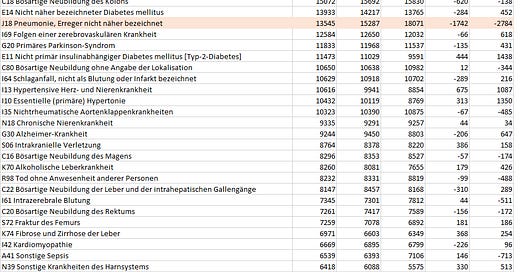Recently, an analysis on German health insurance data by Tom Lausen has aroused some interest (e.g., here). Of course, for most Germans the use of the AfD party as platform proves that the analysis is a big lie, and can safely be disregarded. Not for me. I want to understand the data and compare it to other sources.
One of Lausen’s main points is the massive increase in deaths with ICD codes indicating vague or unspecified causes of death (R96, R98, R99). Health insurance in Germany splits into a private and public sector, the latter comprising between 80% and 90% of the population and forming, as far as I understand, the basis for Lausen’s analysis.
In the analysis, around 15,000 deaths coded R96 (sudden deaths) and around 20,000 deaths coded R99 (other vague or unspecified causes of death) are reported to have been recorded for 2021, an enormous increase on previous years, begging for explanation.
Today, Statistisches Bundesamt (destatis) finally published official statistics on causes of death for 2021 in Germany. For details, we are being referred to the GBE database (GBE = Gesundheitsberichterstattung, if you like German word monsters). From this database, I downloaded annual data for 2019, 2020 and 2021. Unfortunately, the interface only offers the top 100 causes of deaths; it is probably possible to get the full dataset on request.
Without further ado, here’s the data:
Some observations:
I omitted three codes (certain types of cancer) for which the numbers of deaths were crossed out for all years.
The total figures (second row) are the official total numbers of deaths, not just the sums over the rows following.
U07 (blue) are the official Covid deaths (cf. the destatis press release). This code was not used (or at least rare) before 2020 (#NV entries indicate that the code was not in the top 100 in that year).
Many of these would have been classified J18 (orange) in previous years (note that 2019 was a low-influenza year; the figure for 2018 is 19,736). J44 is another candidate (32,796 in 2018).
R99 (green) is up a little from 2021, but not in the order of magnitude as in Lausen’s analysis. Note also that the figure for 2018 is 19,884 only - are we seeing early Covid cases for 2019, or is there a better explanation?
R96 is not in the data, at least not in the top 100.
Some heart-related codes are up (e.g., I51, grey) but maybe this is to be expected in a growing and ageing population.
I don’t know why the R99 figures from 2019 and 2020 are not reflected in Lausen’s data. Nor do I know what happened to the R96 figures. What is the connection between KBV and destatis data? Are the former the basis (or one basis) for the latter, and who changes codes, and when? And who had the glorious idea to use the U07 category to hide all the inconvenient stuff?



